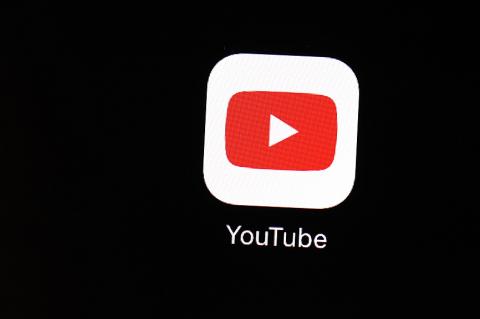Early last month, YouTube made a significant change to its software to boost what it deems to be “quality” children’s content, sending waves of traffic to certain video producers and burying other channels. The change came as the company tries to convince parents that its service is safe for kids and convince regulators that it is not violating the law.
The update immediately alarmed many YouTube content creators, who already feel that their livelihoods hang at the whims of mysterious algorithms.
Kids’ entertainment is massive on YouTube, the Internet video-sharing arm of Alphabet Inc’s Google. It is also incredibly controversial. Because YouTube lets people post clips with few limitations, it has faced blistering criticism for making inappropriate and disturbing footage available to kids. In response, in recent years YouTube has made two notable changes:

Photo: AP
In 2017, it purged dozens of channels behind violent and sexual videos featuring kids or cartoons, and earlier this year it shut off the ability for users to comment on videos starring children following a scandal after evidence surfaced that video comments were used to identify young girls in clips that could be seen as sexually suggestive.
YouTube’s software algorithms determine how videos are placed in search results and viewing recommendations, so the company is notoriously secretive about them.
Thousand of video creators rely on its cloaked system to reach their audience and earn advertising money. Many adjustments to the software are routine, but the latest change stood out.
“Most of the time, we don’t even notice it,” said Melissa Hunter of Family Video Network, a YouTube multi-channel network and consulting firm. “Whatever was tweaked about a week and a half ago was very noticeable.”
YouTube confirmed the recent software update, but declined to detail the reasons behind it.
“We make hundreds of changes every year to make it easier for people to find what they want to watch on YouTube,” company spokeswoman Ivy Choi said in a statement. “We recently made one such change that improves the ability for users to find quality family content.”
PRECIPITOUS DROP
Since the change, some videos aimed at preschoolers saw a precipitous drop in traffic, while others catering to a similar age group saw major spikes, Hunter said.
When the shift occurred, the company did not communicate it to content creators, Hunter and other YouTubers said.
The viewers have not returned.
One content creator posted a chart on July 13 in a private Facebook group showing a 98 percent drop in viewing traffic in three days.
“Is it time to stop creating kids content?” the message read.
YouTube bars minors under 13 from using the site and recommends that children use YouTube Kids, its app with more content filters and parental controls.
However, the app’s reach is small relative to YouTube’s main site and people at the company have privately acknowledged that older children gravitate from the app to the far larger media catalog on YouTube.com.
YouTube recently reached a settlement with the US Federal Trade Commission over allegations that it breached a law that prohibits collecting personal data from minors and serving them targeted ads, Bloomberg News has reported.
The settlement could lead to a potential fine and additional oversight.
Google chief executive officer Sundar Pichai has recently stressed the “educational” value of YouTube.
He told investors last week that YouTube would place “a lot of effort” into its Kids app.
“It’s a product you’re going to see us focus more on and continue to evolve, add more curated content there, and make sure it’s safe for kids and give parents peace of mind,” he said on the company’s earnings call.
The approach also applied to “family-oriented” videos on YouTube.com, Pichai said.
“Rewarding trusted creators is a big way we can help,” he said.
YouTube would not share examples of “trusted creators.”
However, the company pointed to a guideline it publishes for making family videos. The document suggests avoiding footage that looks like it came from “content farms” — repetitious clips that feature the same cartoon truck in different colors, for instance — and “mindless, addictive content that has no substance or developmental value to the viewer.”
A spokeswoman said these guidelines do not determine what videos are recommended, removed or made eligible for ads.
The company also has not detailed how it defines “quality” or “educational” videos. So one of the best barometers for YouTube’s metric is its Kids app, which places videos front-and-center once a viewer logs in.
However, the educational merits of these choices are up for debate.
Heather Kirkorian, a professor of early-childhood development at the University of Wisconsin-Madison, opened the app this week and found Baby Shark and Lucas the Spider, two global hits.
“I wouldn’t consider them educational. I would consider them wholesome,” she said. “The term ‘educational’ is used as an umbrella for ‘non-harmful.’”
Content creators said that YouTube’s recent updates affected both its main site and Kids app. The app’s home screen has tiny icons with recommended videos under the categories “Music,” “Shows” and “Learning.” Some of those channels included there saw recent boosts in views and subscriptions, the key metrics for the service. Those include established producers such as PBS Kids and Mother Goose Club.
Woolly and Tig, a British channel that makes live-action clips of a girl and her stuffed toy, saw a 156 percent increase in views over 30 days, according to Social Blade, a firm that measures YouTube traffic.
Representatives from the Woolly and Tig channel did not immediately respond to a request for comment.
Channels like Woolly and Tig star young children and often feature their parents or other adults.
However, there is another popular genre of YouTube kids’ media: Channels that post nursery rhymes and animated sing-a-longs at an astounding rate, racking up millions of views.
The producers behind them are elusive. James Bridle, a British author, in 2017 wrote an influential post on the Medium online publishing platform about the genre, detailing how these videos create their content and format based on “algorithmically generated keywords.”
“They’re videos made purely to perform well on YouTube,” Bridle wrote.
There are some signs that the algorithm is punishing them. A few of the YouTube channels Bridle cited in the post — such as Finger Family Songs and Videogyan Nursery Rhymes & Baby Songs — saw views fall by more than 25 percent in the past month, according to Social Blade.
Videogyan said it has “not witnessed any major change.”
The other channel could not be reached.
Yet, Social Blade chief executive officer Jason Urgo said that some trends are hard to pinpoint to one catalyst.
“There’s a million reasons why a channel would have a spike in traffic,” Urgo said.
YouTube declined to comment on those channels.
Over the weekend, Hunter said she saw a traffic surge from a particular kind of nursery rhyme video.
ARABIC, KOREAN
The clips explode in animation and color. Several of the clips use video captions with Arabic or Korean phrases for “learning English.” Some videos used both languages.
The channels churn out several videos a week and gain revenue from the ads that run ahead of the footage.
Hunter said that she found them through YouTube’s recommendation engine after viewing clips with English descriptions.
Kirkorian, the development expert, watched videos from two of these channels, ABC Drawing Land and Coco Bin.
She said that although they are not harmful, several of their traits — firing words off quickly, loud background music and frequent text on the screen — were not conducive to how toddlers best learn.
“They’re just proliferating. It’s like a fungus,” Hunter said. “It’s almost as if they’ve found a chink in the armor and they’re exploiting it.”
Neither of the channels Hunter flagged posted contact information on their YouTube pages and so the creators could not be reached for comment.
Choi, the YouTube spokeswoman, said that traffic swings in those channels were unrelated to the recent algorithm adjustment.
She declined to elaborate.
Some content creators are still grappling to understand why YouTube made the changes and how to recover from them.
Nathan Laud, a British animator behind cartoon song channel Tiny Tunes, said that his daily views fell about 80 percent since the algorithm update, mostly due to a drop in traffic from YouTube’s recommendation system.
“My content has one primary aim and that is to be educational,” Laud, a father of two, wrote in an e-mail.
When he asked YouTube about his traffic drop, an e-mail from a company support account replied that there was a change in the “discovery systems” that connect viewers to videos.
It did not detail why his videos were affected.
“After further investigation, we’ve found no issues on your channel,” the e-mail read. “Everything is working as intended.”

Merida Industry Co (美利達) has seen signs of recovery in the US and European markets this year, as customers are gradually depleting their inventories, the bicycle maker told shareholders yesterday. Given robust growth in new orders at its Taiwanese factory, coupled with its subsidiaries’ improving performance, Merida said it remains confident about the bicycle market’s prospects and expects steady growth in its core business this year. CAUTION ON CHINA However, the company must handle the Chinese market with great caution, as sales of road bikes there have declined significantly, affecting its revenue and profitability, Merida said in a statement, adding that it would

Greek tourism student Katerina quit within a month of starting work at a five-star hotel in Halkidiki, one of the country’s top destinations, because she said conditions were so dire. Beyond the bad pay, the 22-year-old said that her working and living conditions were “miserable and unacceptable.” Millions holiday in Greece every year, but its vital tourism industry is finding it harder and harder to recruit Greeks to look after them. “I was asked to work in any department of the hotel where there was a need, from service to cleaning,” said Katerina, a tourism and marketing student, who would

i Gasoline and diesel prices at fuel stations are this week to rise NT$0.1 per liter, as tensions in the Middle East pushed crude oil prices higher last week, CPC Corp, Taiwan (台灣中油) and Formosa Petrochemical Corp (台塑石化) said yesterday. International crude oil prices last week rose for the third consecutive week due to an escalating conflict between Israel and Iran, as the market is concerned that the situation in the Middle East might affect crude oil supply, CPC and Formosa said in separate statements. Front-month Brent crude oil futures — the international oil benchmark — rose 3.75 percent to settle at US$77.01

RISING: Strong exports, and life insurance companies’ efforts to manage currency risks indicates the NT dollar would eventually pass the 29 level, an expert said The New Taiwan dollar yesterday rallied to its strongest in three years amid inflows to the nation’s stock market and broad-based weakness in the US dollar. Exporter sales of the US currency and a repatriation of funds from local asset managers also played a role, said two traders, who asked not to be identified as they were not authorized to speak publicly. State-owned banks were seen buying the greenback yesterday, but only at a moderate scale, the traders said. The local currency gained 0.77 percent, outperforming almost all of its Asian peers, to close at NT$29.165 per US dollar in Taipei trading yesterday. The